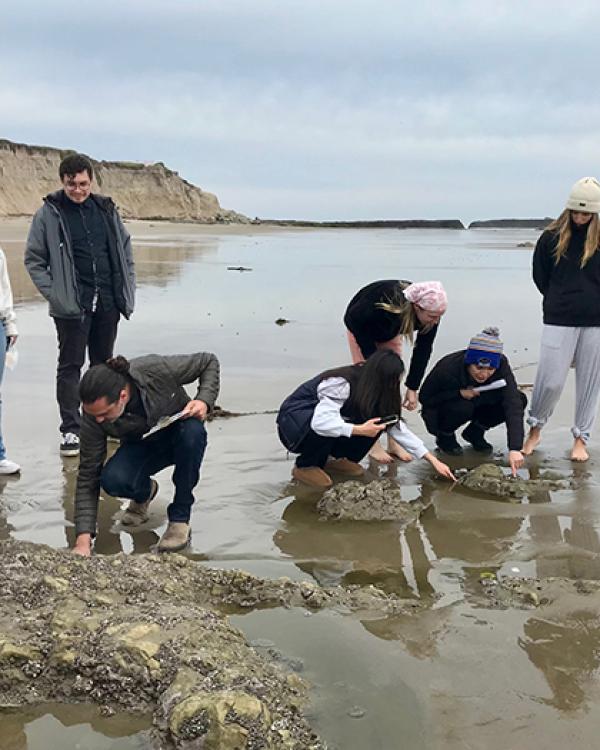
One week, multiple subject candidates in our Teacher Education Program are at Campus Point, gathering objects they find, drawing Venn diagrams in the sand. The next week, the same students are on the Ackerman fourth floor patio of the Education Building, sampling the s’mores they have baked in solar ovens they just designed and built. Might as well taste test as one way to measure whether their ovens did the job.
This is just a small sampling of what happens in Elementary Science Teaching Methods, a course Department of Education Professor Danielle Harlow has been teaching every year since she has been at UCSB. The course has always been active and hands-on, but in the last two years—partially driven by distance teaching and the pandemic—Harlow has redesigned the class. Now it’s built around the UN Sustainable Development Goals that aim to slow the effects of climate change while also working to improve health and education, reduce inequality, and spur economic growth.
“The NGSS [Next Generation Science Standards] is what do we teach in science and the Ambitious Science Teaching Framework is how we teach science, the practices that teachers engage in,” Harlow explains. “So, the question then becomes, what’s our motivation? Why do we teach science? One of the reasons is that students who are in elementary school now will be the adults of the future and they will be needing to understand and address the environmental and social challenges that are being caused by global climate change. And the UN Development Goals are not just about climate change but about protecting and sustainably using life on the land and life on the water, increasing access to clean and affordable energy and clean water, ensuring quality education, reducing inequalities, and making cities sustainable, all the things that we want to happen.” Achieving these ambitious goals require scientists and engineers with innovative ideas—scientists and engineers that could be taught by students graduating from our Teacher Education Program.
The 17 UN Goals kick off with no poverty and zero hunger, and suggest 169 targets and 5503 actions to reach the goals by 2030. Harlow points out some schools use the goals to structure their entire curricula and the Sustainable Development goals have connections to biology, chemistry, physics, earth science, and engineering, thereby allowing students to see how science connects to real world problems. Harlow insists, “Science isn’t just about learning content—it’s about being able to engage in problem-solving, understanding, explaining phenomena and engaging in the practices of science and engineering and learning the content through the practices of science and engineering.”
Take that class at the beach, which also had the benefit of being outside and safer in our COVID times. Life on Land and Life Below Water are two of the UN Sustainable Development Goals, so an intertidal spot met both goals and connected to standards. Second graders, for example, are expected to be able to “Make observations of plants and animals to compare the diversity of life in different habits,” something children naturally do when given an opportunity to explore outside. A kindergarten performance expectation is to “Communicate solutions that will reduce the impact of humans on the land, water, air, and/or other living things in the local environment.”
Then the solar ovens—a common activity in numerous elementary school science curricula—relate to discussions about Affordable and Clean Energy, another UN goal. This is an engineering activity that directly relates to a fourth-grade performance expectation, “Apply scientific ideas to design, test, and refine a device that converts energy from one form to another.” In this case, the solar ovens take solar energy and it is converted to heat. “Later in the quarter we will take the model of the solar ovens and apply that to thinking about changes in our atmosphere that are leading to climate change,” Harlow says, “even if it’s not a perfect match, it’s at least analogous.”
Harlow is enthusiastic about getting her students outside, so they will then be prepared to do the same for their students when they become elementary school teachers. “It’s important for children to be outside and connecting with nature,” she claims. “Not many schools are as fortunate as we are to have a beach right on campus, but there are school gardens, there might be a playground, or a tree planted in front of the school, there’s pockets of nature at every school. These are all places where students can consider, how do people and the environment interact?” Indeed, the California Science Standards, our state’s take on the NGSS, includes environmental principles. Harlow says, “Even young kids can start to look at how to people and the environment interact and what they can do to make things better, they can pick up trash, bring a reusable water bottle with them, or work with others to make bigger differences in their communities. Kids all over the world are making big impacts through their ideas and passion.”
Those efforts to make things better are truly taking root at the Gevirtz School, not just in Harlow’s MST course. She is also the chair of an ad hoc committee of faculty, staff, and students considering all the ways the school can work for sustainable development, from its curriculum to its practices. What’s happening in this class is only one part of the school’s efforts to center sustainability in our classrooms and outreach. The science is clear that we all need to work together to ensure a sustainable future. At the GGSE, we are using our strengths in research and education to do our part towards a sustainable and just future.